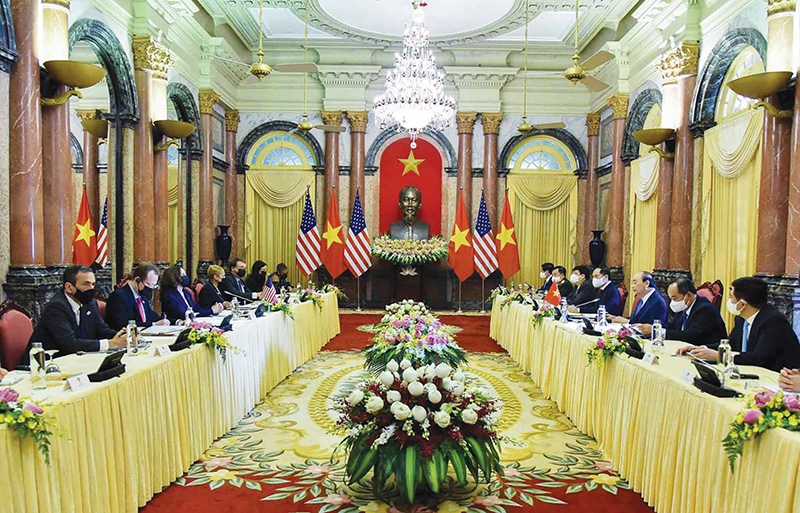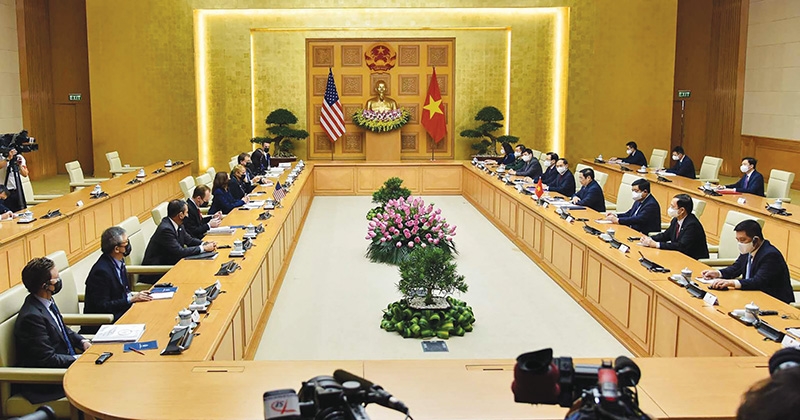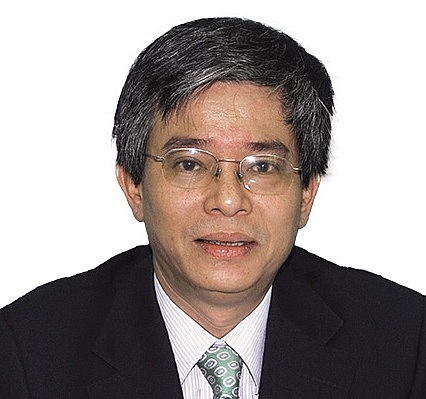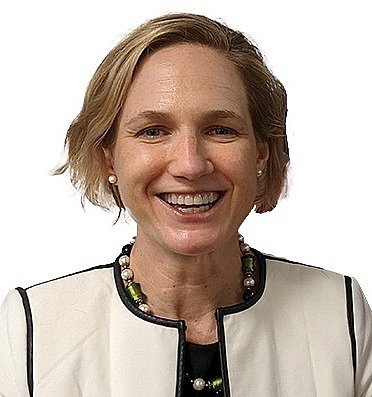Historic US visit lays fresh paths for stronger relations
 |
| The US delegation led by Vice President Kamala Harris met with high-ranking Vietnamese officials |
At 9.45pm last Tuesday, US Vice President Kamala Harris exited Air Force Two to applause from those gathered on a tarmac at Hanoi’s Noi Bai International Airport. She was greeted by a line of masked officials, each putting their arm to their chest instead of shaking hands.
VP Harris came to Vietnam on August 24-26 after concluding a visit to Singapore. The visits aimed to strengthen the US’ engagement in the Indo- Pacific region, with Singapore and Vietnam being a focus in Southeast Asia.
Harris is the first African-American and the first Asian-American to be elected vice president. She is also the first US vice president to pay a visit to Vietnam. She held bilateral meetings with State President Nguyen Xuan Phuc and Prime Minister Pham Minh Chinh during her time in Hanoi.
Furthering ties
The Vietnamese leaders stressed that the country views the US as one of its most important partners.
“Looking back on the past 25 years, we are delighted to note that thanks to the tireless efforts of both sides, the Vietnam-US Comprehensive Partnership has been flourishing, creating greater substance and effectiveness across all areas of bilateral, regional, and global cooperation,” President Phuc said. “Vietnam desires to work jointly with the US to further deepen the comprehensive partnership to promote more substantive, fruitful, long-lasting, and sustainable bilateral ties; build and strengthen mutual trust; and create the foundation for both sides to enhance cooperation for mutual benefits based on mutual respect for independence, sovereignty, territorial integrity and the political regime of each country.”
According to the White House, bilateral relations have made significant strides to the point where they now cooperate on a wide range of issues, including fighting COVID-19 and preparing for future health security threats, combatting climate change, and addressing shared legacies of war.
“We have deepened our economic ties as Vietnam’s second-largest trading partner and its top export market worldwide, and our support for one another is mutually reinforcing: a vibrant Vietnamese economy is critical to the supply chains Americans depend on, a point that COVID-19 has made clear when production shutdowns abroad have led to difficulties in shipping goods at home,” said a White House statement released last week.
Vice President Harris reaffirmed the US commitment to a strong, prosperous, and independent Vietnam, as well as a free, open, healthy, and resilient Indo-Pacific region.
Vietnam and the US during this visit riveted their bilateral ties in many sectors, including COVID-19 and health security; combatting climate change; development assistance and market access; addressing the legacy of war issues; security; investments in the bilateral relationship; peaceful exploration of space; and higher education.
“I would also ask that we consider doing what we can to upgrade to a strategic partnership. This will send a positive message to our governments, and our people, and the region as we deepen our relationship,” Harris said. “We will work closely with Vietnam to uphold rule-based international freedom of navigation, an issue that we take seriously, and including, as it relates to the South China Sea [known as the East Sea in Vietnam].”
She emphasised the Biden-Harris administration’s grand efforts to promote economic growth and opportunities with Vietnam. Specifically, the US will support Vietnam in promoting women and ethnic-minority owned enterprises. The US government announced the Improving Private Sector Competitiveness project, a $36 million United States Agency for International Development (USAID) flagship effort to grow women and ethnic minority-owned businesses and promote job growth in rural areas through the adoption of new American technology.
The US will also provide support for Vietnam’s transition to a digital economy. It announced the Workforce for an Innovation and Startup Ecosystem, a USAID scheme providing up to $2 million to support Vietnam’s effort to transition from an economy dominated by labour-intensive, low-skilled industry to a workforce better equipped to participate in the global digital economy. Building Vietnam’s digital skills will increase opportunities for trade between the US and Vietnam and will promote US technologies.
Notably, there will likely be lower tariffs on US exports to Vietnam. “US farmers and pork producers will have greater access to markets in Vietnam - the US’ seventh-largest agricultural export market - as a result of Vietnam’s positive consideration of our proposal to eliminate or reduce most-favoured nation import duties on corn, wheat, and pork products. These tariff cuts allow US farmers to provide Vietnam with quality and competitively-priced products while also helping reduce the US trade deficit with Vietnam,” said a White House statement released during the visit.
Harris also highlighted economic engagement as being at the forefront of the US. “Twenty-six years ago, our economic relationship was nearly non-existent. Now, Vietnam is one of our top 10 trading partners in the world, and its economy is critical to the supply chains that we rely on. That is a big area of focus for us here in Southeast Asia and, in particular, in Vietnam.”
Figures from Vietnam’s General Statistics Office showed that in the first seven months of this year, the US was Vietnam’s largest export market, with total turnover of $53.7 billion, up 37.7 per cent on-year, and the US was also Vietnam’s sixth-largest import market, with importers using $8.97 billion to purchase goods from the US, up 10.6 per cent as compared to the corresponding period last year.
Regarding security cooperation, the US supports Vietnam’s enhancement of its maritime security and law enforcement capabilities. Both sides reaffirmed their commitment to continuing high-level security cooperation in support of a strong, prosperous and independent Vietnam, including humanitarian engagements like the Pacific Partnership and visits by US ships, including aircraft carriers.
 |
Strengthening momentum
Much had expected that Vietnam and the US would raise bilateral relations to a strategic partnership during Vice President Harris’ visit from the existing comprehensive partnership. However, such a strategic partnership may take longer to materialise.
Explaining why Vietnam is so important to the US, Carl Thayer, emeritus professor at the University of New South Wales, said that since the Obama administration, every US national security strategy has identified Vietnam as a key potential security partner of the US. This was also true for the Trump administration.
In fact, president Biden issued the Interim National Security Strategic Guidance in March. The general themes of this strategy are clear, explained Thayer, in that the US will reengage with Southeast Asia as part of its larger strategy of giving priority to the Indo-Pacific. This document listed Singapore and Vietnam as the two priority security partners in Southeast Asia.
“Under the Biden administration developing a partnership with Vietnam is a key priority,” Thayer said. “Vietnam is important to the US because it also plays a constructive role in ASEAN and is well-respected by the international community as evidenced by its election twice as non-permanent member of the UN Security Council.”
| Vietnam-US cooperation in health and climate change COVID-19 and health security: The vice president reinforced the US’ commitment to leading the world in ending the COVID-19 pandemic. She announced new COVID-19 vaccine donations to Vietnam, critical support for vaccine distribution, and the opening of a new regional Centers for Disease Control and Prevention (CDC) office to enhance health security cooperation. - Vaccine donation: Recognising the critical toll that the COVID-19 has taken on both our countries, and the Biden-Harris administration’s effort to serve as an arsenal of vaccines for the world, the vice president announced that the US is donating an additional one million doses of Pfizer vaccine to Vietnam, bringing our total donation to Vietnam to six million doses. - COVID-19 technical and programmatic assistance: Through the American Rescue Plan Act and other emergency assistance funding to date, USAID and the CDC are supporting Vietnam’s response to COVID-19 with an additional $23 million in technical assistance and programmatic support, bringing the total assistance provided since the start of the pandemic to nearly $44 million. This assistance will accelerate equitable access to and delivery of safe and effective COVID-19 vaccines, strengthen Vietnam’s health system to respond to COVID-19, and build capacity to detect and monitor COVID-19 and future disease threats. USAID also provided the Vietnam Red Cross $1 million to reduce the impacts and prevent the spread of COVID-19 in vulnerable communities. - Support for vaccine distribution: The Department of Defense has committed to providing 77 ultra-low temperature vaccine freezers to assist vaccination distribution efforts in all 63 provinces. These freezers are specially designed to accommodate the most extreme vaccine storage requirements, significantly enhancing Vietnam’s national vaccine distribution network. - Emergency Operations: Through the Defense Threat Reduction Agency, the US provided two regional public health emergency operations centres, which are now operating 24/7 to collect and share COVID-19 surveillance information through the Ministry of Health. - Launch of the new CDC Southeast Asia Regional Office: The vice president launched the US CDC Southeast Asia Regional Office in Hanoi. The CDC office will advance global health security by maintaining a sustainable presence in the region, enabling a rapid and effective response to health threats -wherever they occur - and reinforcing CDC’s core mission of protecting Americans. Combatting climate change: The vice president and Vietnamese government and civil society leaders agreed on the importance of combatting the climate crisis, increasing resilience, and collaborating towards a clean energy future. - Leveraging the private sector in climate action: USAID and the Vietnam Chamber of Commerce and Industry (VCCI) signed an MoU to boost Vietnam’s competitiveness, expand market opportunities for US companies, and strengthen Vietnam’s environmental policy. This MoU with the VCCI will improve the its focus on sustainability, green technology, and climate change. USAID also intends to support the VCCI in developing a green index to help US businesses select provinces that are investing in green operations. - Expanding clean energy and electric vehicles: The US government announced the Vietnam Low Emission Energy Programme II, a 5-year, $36 million USAID project which aims to accelerate Vietnam’s transition to a clean, secure, and market-driven energy system. The project will work to improve government energy planning, increase competition to encourage US private sector involvement in energy service provision, and increase clean energy systems. The project will help Vietnam scale up the adoption of electric motorbikes and implement the direct power purchase agreement mechanism to allow businesses to procure electricity directly from private firms producing renewable energy. - Protecting the Mekong Delta region: Through USAID, the US government launched the Mekong Coastal Habitat Conservation project, a new 3-year, $2.9 million initiative with the International Union for Conservation of Nature. This project aims to protect key coastal habitats in the Mekong Delta region for sustainable fisheries, climate change adaptation and biodiversity conservation. - Accelerating climate-smart agriculture: The US welcomed Vietnam joining the Agricultural Innovation Mission for Climate, an initiative announced at President Biden’s Leaders’ Summit on Climate that will be launched at COP26 in November. The mission participants will work together to accelerate global agricultural innovation and the adoption of climate-smart technologies. Source: White House |
Pham Quang Vinh - Former Vietnamese Ambassador to the United States
 |
Over the past many years, Vietnam-US economic and trade ties have been growing from strength to strength, both quantitatively and qualitatively, and the US is now Vietnam’s largest export market.
The longer the trade ties become, the more common benefits can be multiplied. However, there have also been some differences. This has happened not only in the Vietnam-US trade cooperation but also in that among many other nations. The differences can be seen in demands, standards, legal regulations, and customs.
Under the previous US administration, the trade deficit was considered the biggest issue that needed to be solved in foreign trade relations with other nations, including Vietnam. However, it is necessary to have good understanding about the nature of this deficit.
Firstly, the trade deficit between Vietnam and the US does not come from policy fraud. Vietnam totally opposes this as it would harm the economy and the country’s international integration efforts.
Vietnam is strong in goods production while the US is strong in technology and service development. The US exports to many other nations including Vietnam, creating a surplus in technology and service, but suffering from a deficit in goods.
Economically, the two economies are supplementing, not overlapping, each other. The US economy needs a huge volume of goods, and if it does not purchase from Vietnam, it will have to buy from other markets. But why has it selected Vietnam’s goods? It is all about the quality, prices, and trust.
Secondly, it is about the monetary issue which can have an impact on exports. This issue began to be mentioned at the end of the former president’s tenure. After President Biden took office in January 2021, both sides exchanged ideas and set up a dialogue channel.
At that time, the US expressed its concern over the two nations’ trade relations and Vietnam’s management of the USD/VND exchange rate. Then Vietnam clearly explained that the two economies’ trade ties are mutually healthy and complementary.
Vietnam has been trying to purchase more US goods, such as liquefied natural gas and aircraft. However, because its financial health is not very strong, Vietnam cannot buy more.
Vietnam also elaborated that its monetary management is aimed to ensure its macroeconomic stability, not drive the exchange rate to an unsound trajectory and distort trade. Vietnam also strongly reaffirmed that it resolutely fights against origin fraud.
Such consultancy is very constructive, with solutions benefiting both sides. The US Trade Representative office said it had determined that no tariff action against Vietnam was warranted after the State Bank of Vietnam agreed with the US Treasury not to manipulate its currency for export advantage.
Thus it is clear to see that Vietnam and the US have shared trust.
David B. Shear - Former US Ambassador to Vietnam
 |
Vietnam and the US do indeed have a very strong bilateral relationship. Vietnam is important to the US and to the region. The Vietnamese economy grew by almost 3 per cent in 2020, even during the COVID-19 crisis. The US and Vietnam did nearly $80 billion in two-way trade in 2020, there were 26,000 Vietnamese students studying in the US, and we have strong family ties, too. I even have Vietnamese relatives.
Of course, as a diplomat, I also have to say that we share strong common interests throughout the region. That is why we are sending our Vice President Kamala Harris, the first sitting VP to visit Vietnam since we established relations.
I look forward to the establishment of a strategic partnership. It is because it will better reflect the strength of our mutual ties and our strong common interests in the region.
Public health is a strong theme during this trip. Both our countries are now suffering from a spike in COVID-19 cases, and the US wants to do all it can to assist our Vietnamese friends.
Vice President Harris has announced the establishment in Vietnam of a regional office of the American Centers for Disease Control. Our cooperation in public health has always been very strong, and this will further cement close ties in the field including but not limited to COVID-19.
It is clear that public health has become a key element in our promotion of a free and open Indo-Pacific region, but economic growth and national security are also key elements.
The US has long encouraged Vietnamese economic growth through our strong trade and investment ties and through our support for economic reform.
Lynne Gadkowski - Economic counselor, US Embassy to Vietnam
 |
We see tremendous market opportunities in Vietnam for US goods and services in the fields of ag-riculture, aviation, education, energy, healthcare, and smart cities technologies, to name a few. And our two countries are increasingly linked through global supply chains: American-made computer chips, hardwood, cotton, and animal feed fuel Vietnam’s exports of semiconductors, furniture, ap-parel, and seafood to the United States and diverse markets around the globe.
American firms have also played a leading role in Vietnam’s rapid economic development by investing billions of US dollars here, integrating Vietnam into global supply chains, creating high-quality jobs, and powering Vietnam’s fast-growing economy. In the energy sector, American investors are at the forefront of transitioning Vietnam away from coal toward a clean energy future.
And investment doesn’t just flow one way anymore: enterprising Vietnamese companies with aspirations beyond their own borders are increasingly setting their sights on the United States.
Vietnamese firms in the food and beverage, financial technology and apparel sectors all attended the June 2021 Virtual Select USA Summit, the highest profile event dedicated to promoting foreign direct investment in the United States. The US mission has spoken with dozens more Vietnamese businesses interested in gaining a foothold in the vast American market.
While the United States and Vietnam have had tremendous success in growing our economic ties, we do occasionally have disagreements. This is common among all our trading partners, and the more we trade, the more we have trade issues to discuss. As always, we work together to find pragmatic solutions. We are working with our Vietnamese counterparts to remove market barriers facing US products, so Vietnamese consumers can access world class American goods and services – including in the digital realm.
We are working to improve the business climate, so American firms can compete openly and fairly, and I am confident we can resolve these issues constructively.
The US and Vietnam have an opportunity to expand our economic partnership to tackle some of the world’s most pressing challenges, from beating back the pandemic and restoring the global economy to reducing emissions and confronting the climate crisis.
As a manufacturing powerhouse, Vietnam is playing an integral role in ensuring diverse and secure global supply chains to bolster a strong global economic recovery.
On climate, Vietnam is setting the pace for renewable energy deployment in Southeast Asia, but still faces challenges in reducing emissions overall. The United States and our world class American companies are committed partners in these efforts, as we take our trade and investment relationship to even greater heights.
What the stars mean:
★ Poor ★ ★ Promising ★★★ Good ★★★★ Very good ★★★★★ Exceptional
Related Contents
Latest News
More News
- Vietnam’s green transition demands collective financial action (December 15, 2025 | 12:00)
- VIR workshop highlights capital and policy for sustainable development (December 15, 2025 | 11:00)
- National Assembly approves pilot mechanisms to accelerate major projects in Hanoi (December 12, 2025 | 11:29)
- Vietnam eases policy approval requirements, simplifies foreign and outbound investments (December 11, 2025 | 17:53)
- Unpacking new momentum in Vietnam’s M&A market (December 10, 2025 | 09:59)
- Forum honours outstanding M&A deals, strategies, and advisory firms (December 09, 2025 | 18:22)
- Vietnam enters defining phase of M&A growth (December 09, 2025 | 17:00)
- Vietnam’s M&A market opens new opportunities amid strong economic momentum (December 09, 2025 | 15:00)
- Vietnam M&A Forum 2025: new position, new momentum (December 09, 2025 | 14:30)
- FDI in Vietnam jumps on additional capital and share purchases (December 09, 2025 | 13:56)

 Tag:
Tag:






















 Mobile Version
Mobile Version